Literature Review of FRP Confinement in Reinforced Concrete Columns
VerifiedAdded on 2023/04/22
|15
|3370
|122
Literature Review
AI Summary
This literature review examines the application of Fiber Reinforced Polymer (FRP) in confining Reinforced Concrete (RC) columns to enhance their compressive strength. It analyzes various studies and investigations conducted over the past five years, focusing on the physical and mechanical properties of FRP materials, available confinement models, and the impact of model parameters on compressive strength. The review covers topics such as stress-strain relationships, the effectiveness of different FRP configurations (e.g., circular vs. square sections), and hybrid techniques. It also discusses the use of FRP in repairing damaged concrete and the limitations of existing research, highlighting the potential for future investigations using mixed-method approaches. This paper is aimed to provide a comprehensive understanding of FRP confinement in RC columns.
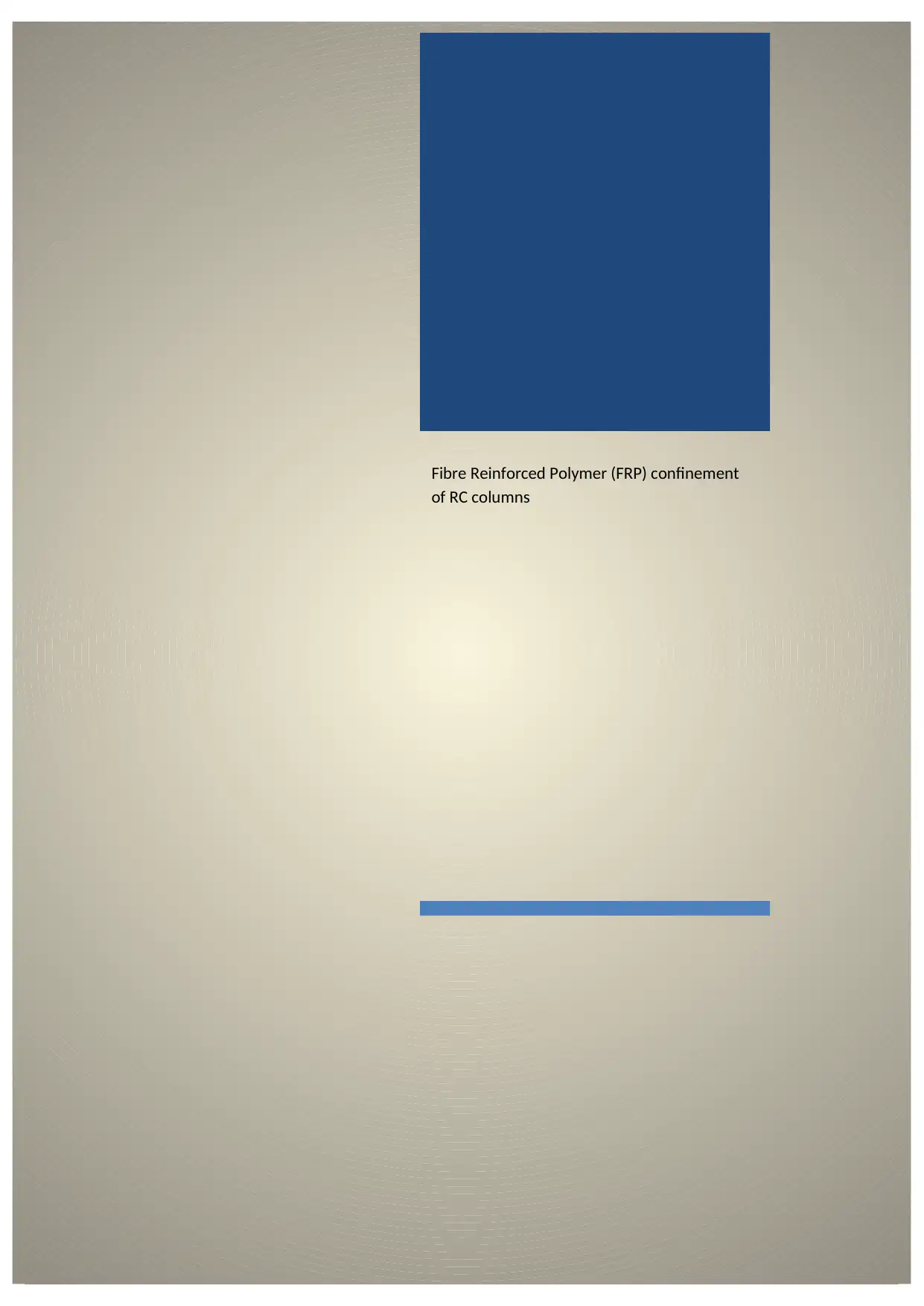
Fibre Reinforced Polymer (FRP) confinement
of RC columns
of RC columns
Paraphrase This Document
Need a fresh take? Get an instant paraphrase of this document with our AI Paraphraser
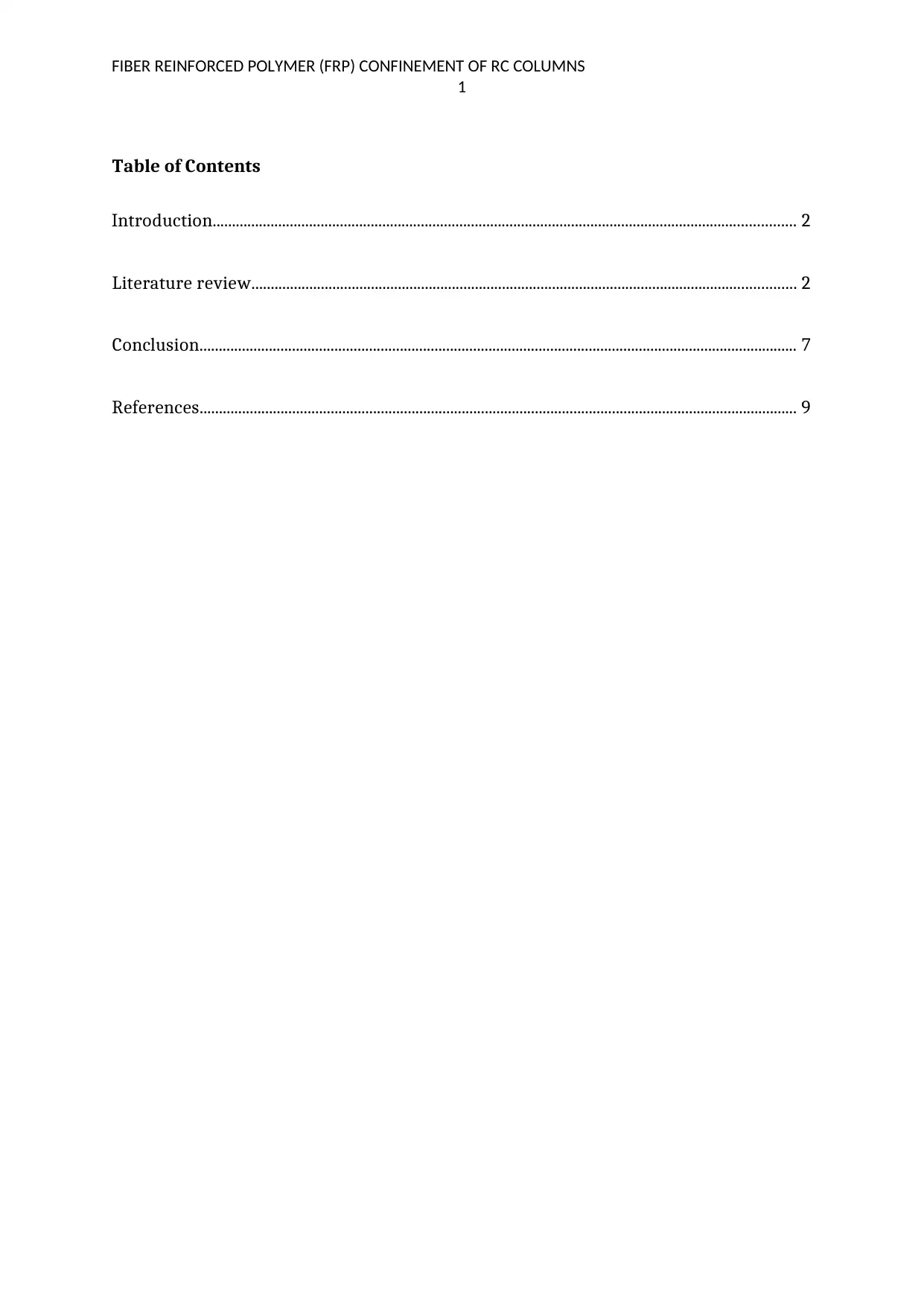
FIBER REINFORCED POLYMER (FRP) CONFINEMENT OF RC COLUMNS
1
Table of Contents
Introduction....................................................................................................................................................... 2
Literature review............................................................................................................................................. 2
Conclusion........................................................................................................................................................... 7
References........................................................................................................................................................... 9
1
Table of Contents
Introduction....................................................................................................................................................... 2
Literature review............................................................................................................................................. 2
Conclusion........................................................................................................................................................... 7
References........................................................................................................................................................... 9
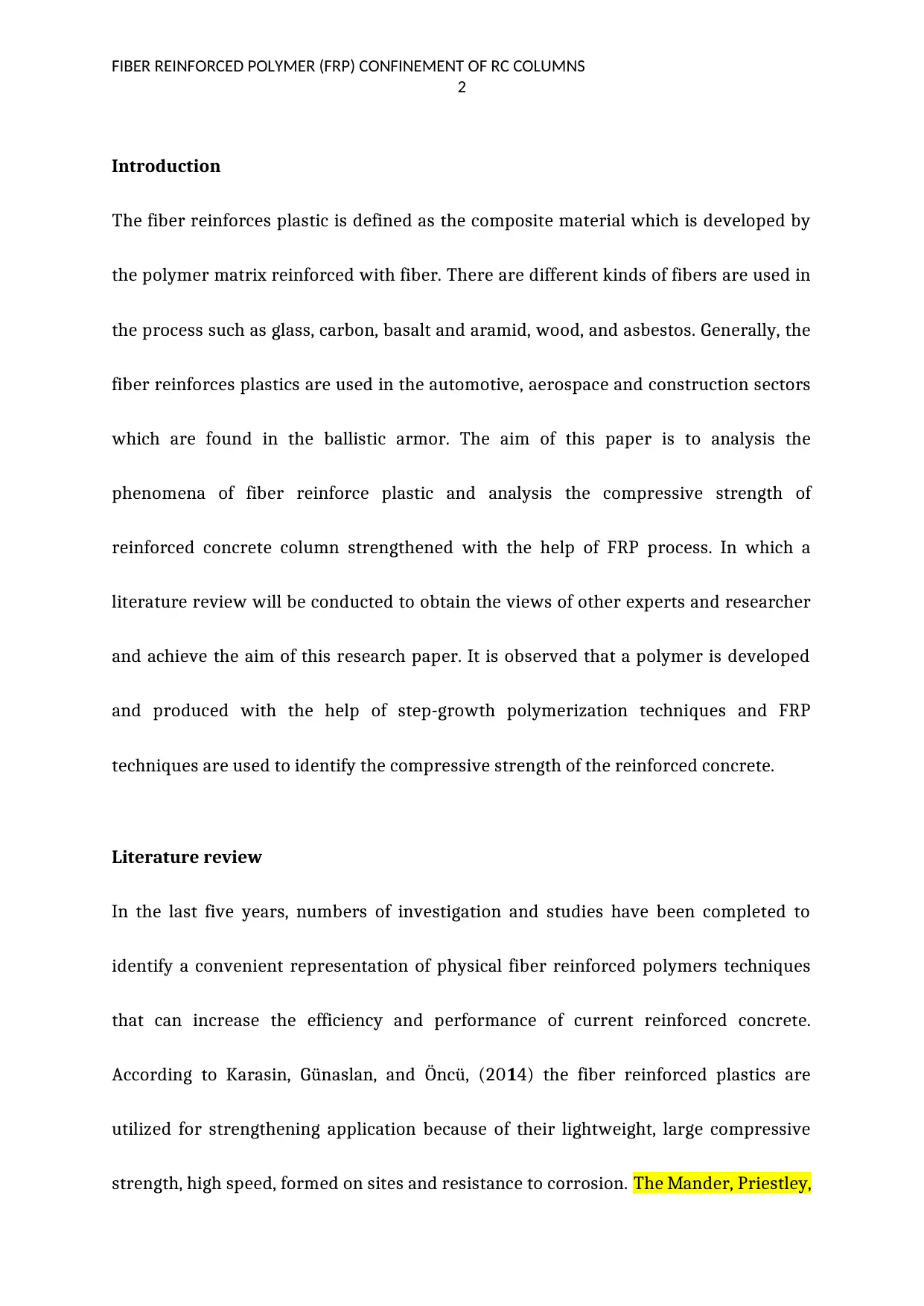
FIBER REINFORCED POLYMER (FRP) CONFINEMENT OF RC COLUMNS
2
Introduction
The fiber reinforces plastic is defined as the composite material which is developed by
the polymer matrix reinforced with fiber. There are different kinds of fibers are used in
the process such as glass, carbon, basalt and aramid, wood, and asbestos. Generally, the
fiber reinforces plastics are used in the automotive, aerospace and construction sectors
which are found in the ballistic armor. The aim of this paper is to analysis the
phenomena of fiber reinforce plastic and analysis the compressive strength of
reinforced concrete column strengthened with the help of FRP process. In which a
literature review will be conducted to obtain the views of other experts and researcher
and achieve the aim of this research paper. It is observed that a polymer is developed
and produced with the help of step-growth polymerization techniques and FRP
techniques are used to identify the compressive strength of the reinforced concrete.
Literature review
In the last five years, numbers of investigation and studies have been completed to
identify a convenient representation of physical fiber reinforced polymers techniques
that can increase the efficiency and performance of current reinforced concrete.
1According to Karasin, Günaslan, and Öncü, (20 4) the fiber reinforced plastics are
utilized for strengthening application because of their lightweight, large compressive
strength, high speed, formed on sites and resistance to corrosion. The Mander, Priestley,
2
Introduction
The fiber reinforces plastic is defined as the composite material which is developed by
the polymer matrix reinforced with fiber. There are different kinds of fibers are used in
the process such as glass, carbon, basalt and aramid, wood, and asbestos. Generally, the
fiber reinforces plastics are used in the automotive, aerospace and construction sectors
which are found in the ballistic armor. The aim of this paper is to analysis the
phenomena of fiber reinforce plastic and analysis the compressive strength of
reinforced concrete column strengthened with the help of FRP process. In which a
literature review will be conducted to obtain the views of other experts and researcher
and achieve the aim of this research paper. It is observed that a polymer is developed
and produced with the help of step-growth polymerization techniques and FRP
techniques are used to identify the compressive strength of the reinforced concrete.
Literature review
In the last five years, numbers of investigation and studies have been completed to
identify a convenient representation of physical fiber reinforced polymers techniques
that can increase the efficiency and performance of current reinforced concrete.
1According to Karasin, Günaslan, and Öncü, (20 4) the fiber reinforced plastics are
utilized for strengthening application because of their lightweight, large compressive
strength, high speed, formed on sites and resistance to corrosion. The Mander, Priestley,
⊘ This is a preview!⊘
Do you want full access?
Subscribe today to unlock all pages.

Trusted by 1+ million students worldwide
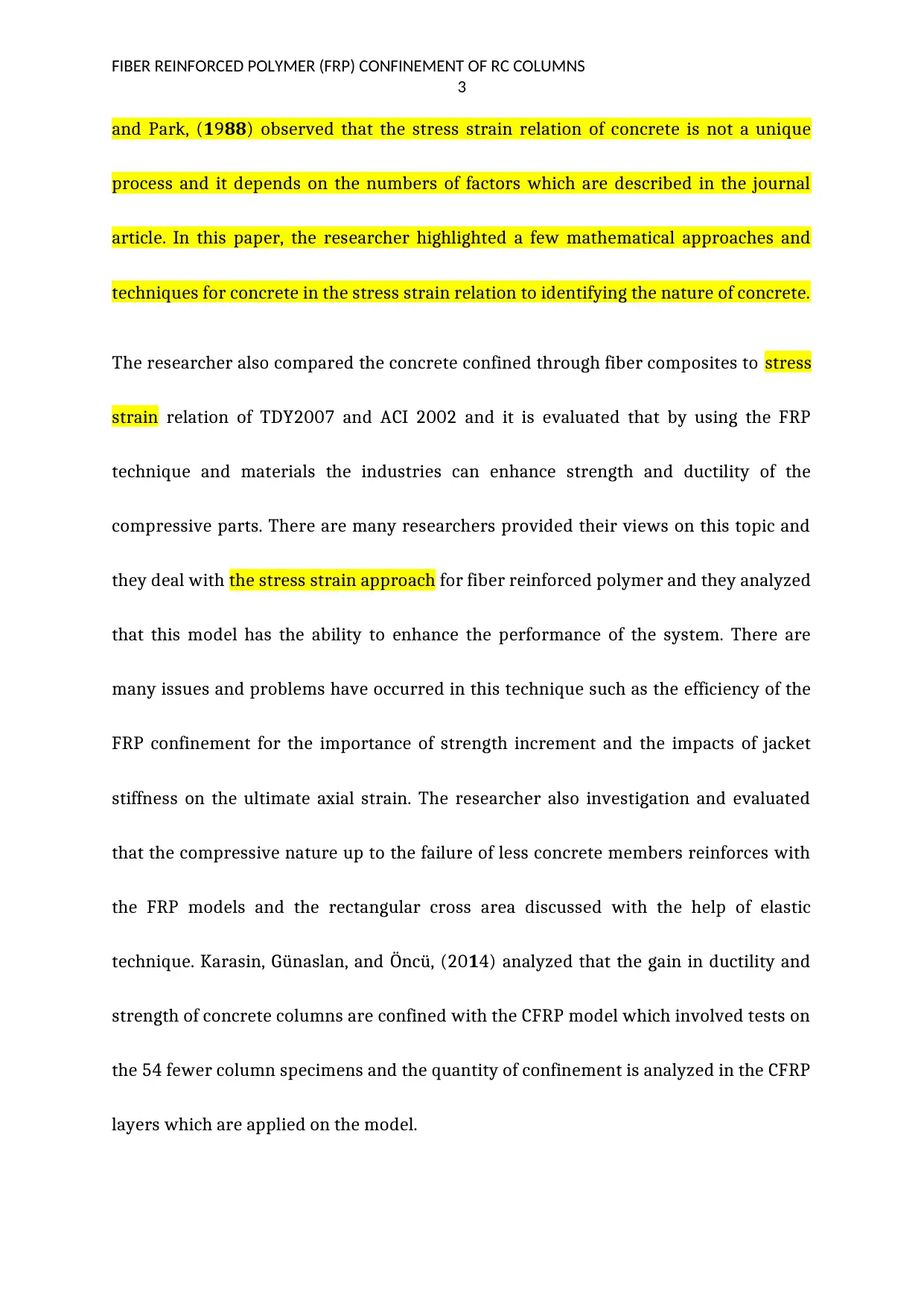
FIBER REINFORCED POLYMER (FRP) CONFINEMENT OF RC COLUMNS
3
1 88and Park, ( 9 ) observed that the stress strain relation of concrete is not a unique
process and it depends on the numbers of factors which are described in the journal
article. In this paper, the researcher highlighted a few mathematical approaches and
techniques for concrete in the stress strain relation to identifying the nature of concrete.
The researcher also compared the concrete confined through fiber composites to stress
strain relation of TDY2007 and ACI 2002 and it is evaluated that by using the FRP
technique and materials the industries can enhance strength and ductility of the
compressive parts. There are many researchers provided their views on this topic and
they deal with the stress strain approach for fiber reinforced polymer and they analyzed
that this model has the ability to enhance the performance of the system. There are
many issues and problems have occurred in this technique such as the efficiency of the
FRP confinement for the importance of strength increment and the impacts of jacket
stiffness on the ultimate axial strain. The researcher also investigation and evaluated
that the compressive nature up to the failure of less concrete members reinforces with
the FRP models and the rectangular cross area discussed with the help of elastic
1technique. Karasin, Günaslan, and Öncü, (20 4) analyzed that the gain in ductility and
strength of concrete columns are confined with the CFRP model which involved tests on
the 54 fewer column specimens and the quantity of confinement is analyzed in the CFRP
layers which are applied on the model.
3
1 88and Park, ( 9 ) observed that the stress strain relation of concrete is not a unique
process and it depends on the numbers of factors which are described in the journal
article. In this paper, the researcher highlighted a few mathematical approaches and
techniques for concrete in the stress strain relation to identifying the nature of concrete.
The researcher also compared the concrete confined through fiber composites to stress
strain relation of TDY2007 and ACI 2002 and it is evaluated that by using the FRP
technique and materials the industries can enhance strength and ductility of the
compressive parts. There are many researchers provided their views on this topic and
they deal with the stress strain approach for fiber reinforced polymer and they analyzed
that this model has the ability to enhance the performance of the system. There are
many issues and problems have occurred in this technique such as the efficiency of the
FRP confinement for the importance of strength increment and the impacts of jacket
stiffness on the ultimate axial strain. The researcher also investigation and evaluated
that the compressive nature up to the failure of less concrete members reinforces with
the FRP models and the rectangular cross area discussed with the help of elastic
1technique. Karasin, Günaslan, and Öncü, (20 4) analyzed that the gain in ductility and
strength of concrete columns are confined with the CFRP model which involved tests on
the 54 fewer column specimens and the quantity of confinement is analyzed in the CFRP
layers which are applied on the model.
Paraphrase This Document
Need a fresh take? Get an instant paraphrase of this document with our AI Paraphraser

FIBER REINFORCED POLYMER (FRP) CONFINEMENT OF RC COLUMNS
4
On the basis of the frameworks and outcomes, the equations were developed to
determine the confined concrete strength and the ultimate confined strain as the
function of the lateral stress. It is observed that the square section of the FRP model is
very less effective in for confining concrete layer as compared to the circular section
and the overall effectiveness is calculated with the help of advanced confinement ratio
which is a function of the corner radium. The researcher also provided a modern
technology for the reinforced plastic and seismic strengthening of the concrete column
which needs the wrapping thin, flexible strength fiber to enhance the confinement.
An analytical model is produced by the 1Toutanji, ( 999) that concrete columns with the
composite straps that can be utilized for improving the strength and ductility of the
concrete columns. With the help of this approach, individuals can enhance the axial
carrying ability of the column and the ductility element increase linearly with the strap
thickness. Researcher included the opinions of the other authors for improving the
effectiveness of the investigation and the theoretical information is collected from
various resources such as journal paper, peer-reviewed articles, and books related to
the fiber reinforced plastic model. According to 1Günaslan, Karaşin, and Öncü, (20 4) the
FRP composite wraps were utilized to repair the injured concrete in the critically
stresses sector near the column footing edge and it shows that the use of repair
approach is more effectively rather than other. It is highlighted that reinforce concrete
4
On the basis of the frameworks and outcomes, the equations were developed to
determine the confined concrete strength and the ultimate confined strain as the
function of the lateral stress. It is observed that the square section of the FRP model is
very less effective in for confining concrete layer as compared to the circular section
and the overall effectiveness is calculated with the help of advanced confinement ratio
which is a function of the corner radium. The researcher also provided a modern
technology for the reinforced plastic and seismic strengthening of the concrete column
which needs the wrapping thin, flexible strength fiber to enhance the confinement.
An analytical model is produced by the 1Toutanji, ( 999) that concrete columns with the
composite straps that can be utilized for improving the strength and ductility of the
concrete columns. With the help of this approach, individuals can enhance the axial
carrying ability of the column and the ductility element increase linearly with the strap
thickness. Researcher included the opinions of the other authors for improving the
effectiveness of the investigation and the theoretical information is collected from
various resources such as journal paper, peer-reviewed articles, and books related to
the fiber reinforced plastic model. According to 1Günaslan, Karaşin, and Öncü, (20 4) the
FRP composite wraps were utilized to repair the injured concrete in the critically
stresses sector near the column footing edge and it shows that the use of repair
approach is more effectively rather than other. It is highlighted that reinforce concrete

FIBER REINFORCED POLYMER (FRP) CONFINEMENT OF RC COLUMNS
5
process with the FRP material for strengthening can cause the increment of
compressive strength of the confined real.
The results of the confined process are compared with the approach of concrete
corresponding to stress strain with the help of FRP TDY2007 and ACI 2002. In the end,
the author concluded that by using fiber reinforce polymer technique and material can
enhance the ductility and strength of the compressive sections. From the result, it is
observed that the stress strain relation of the concrete material is not unique and there
are numerous mathematical models produced by the researcher for the FRP model. In
which the researcher uses the qualitative and quantitative research methods for
enhancing the effectiveness of the research and all relevant data indicated in the form of
chart of the graph for better understanding. The concrete model develops by
Homestead is used for the stress strain to provide the behavior of normal strength. The
Kent and park provided a stress strain model and proposed an equation for confined
and unconfined concrete.
1Monti, and Petrone, (20 4) provided their views on the topic of the fiber reinforced
1polymer and proposed in the EN 990 for understanding the FRP model. The aim of this
journal paper is to analysis the concept of fiber reinforce polymer and compare
experimental outcomes with the theoretical outcomes. In which the Monti, and Petrone,
1(20 4) developed a capacity model on the basis of theoretical or non-practical
5
process with the FRP material for strengthening can cause the increment of
compressive strength of the confined real.
The results of the confined process are compared with the approach of concrete
corresponding to stress strain with the help of FRP TDY2007 and ACI 2002. In the end,
the author concluded that by using fiber reinforce polymer technique and material can
enhance the ductility and strength of the compressive sections. From the result, it is
observed that the stress strain relation of the concrete material is not unique and there
are numerous mathematical models produced by the researcher for the FRP model. In
which the researcher uses the qualitative and quantitative research methods for
enhancing the effectiveness of the research and all relevant data indicated in the form of
chart of the graph for better understanding. The concrete model develops by
Homestead is used for the stress strain to provide the behavior of normal strength. The
Kent and park provided a stress strain model and proposed an equation for confined
and unconfined concrete.
1Monti, and Petrone, (20 4) provided their views on the topic of the fiber reinforced
1polymer and proposed in the EN 990 for understanding the FRP model. The aim of this
journal paper is to analysis the concept of fiber reinforce polymer and compare
experimental outcomes with the theoretical outcomes. In which the Monti, and Petrone,
1(20 4) developed a capacity model on the basis of theoretical or non-practical
⊘ This is a preview!⊘
Do you want full access?
Subscribe today to unlock all pages.

Trusted by 1+ million students worldwide
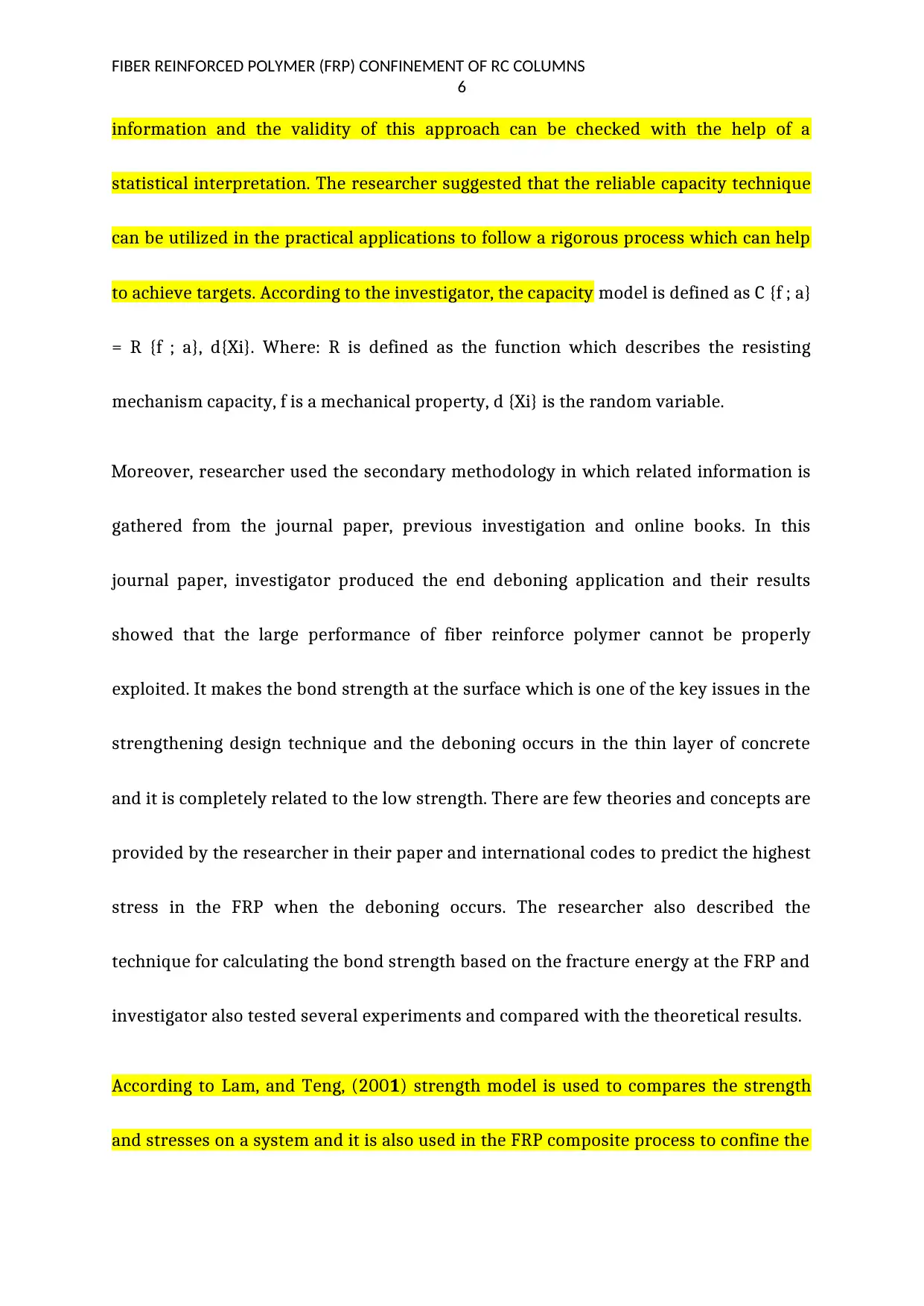
FIBER REINFORCED POLYMER (FRP) CONFINEMENT OF RC COLUMNS
6
information and the validity of this approach can be checked with the help of a
statistical interpretation. The researcher suggested that the reliable capacity technique
can be utilized in the practical applications to follow a rigorous process which can help
to achieve targets. According to the investigator, the capacity model is defined as C {f ; a}
= R {f ; a}, d{Xi}. Where: R is defined as the function which describes the resisting
mechanism capacity, f is a mechanical property, d {Xi} is the random variable.
Moreover, researcher used the secondary methodology in which related information is
gathered from the journal paper, previous investigation and online books. In this
journal paper, investigator produced the end deboning application and their results
showed that the large performance of fiber reinforce polymer cannot be properly
exploited. It makes the bond strength at the surface which is one of the key issues in the
strengthening design technique and the deboning occurs in the thin layer of concrete
and it is completely related to the low strength. There are few theories and concepts are
provided by the researcher in their paper and international codes to predict the highest
stress in the FRP when the deboning occurs. The researcher also described the
technique for calculating the bond strength based on the fracture energy at the FRP and
investigator also tested several experiments and compared with the theoretical results.
According to 1Lam, and Teng, (200 ) strength model is used to compares the strength
and stresses on a system and it is also used in the FRP composite process to confine the
6
information and the validity of this approach can be checked with the help of a
statistical interpretation. The researcher suggested that the reliable capacity technique
can be utilized in the practical applications to follow a rigorous process which can help
to achieve targets. According to the investigator, the capacity model is defined as C {f ; a}
= R {f ; a}, d{Xi}. Where: R is defined as the function which describes the resisting
mechanism capacity, f is a mechanical property, d {Xi} is the random variable.
Moreover, researcher used the secondary methodology in which related information is
gathered from the journal paper, previous investigation and online books. In this
journal paper, investigator produced the end deboning application and their results
showed that the large performance of fiber reinforce polymer cannot be properly
exploited. It makes the bond strength at the surface which is one of the key issues in the
strengthening design technique and the deboning occurs in the thin layer of concrete
and it is completely related to the low strength. There are few theories and concepts are
provided by the researcher in their paper and international codes to predict the highest
stress in the FRP when the deboning occurs. The researcher also described the
technique for calculating the bond strength based on the fracture energy at the FRP and
investigator also tested several experiments and compared with the theoretical results.
According to 1Lam, and Teng, (200 ) strength model is used to compares the strength
and stresses on a system and it is also used in the FRP composite process to confine the
Paraphrase This Document
Need a fresh take? Get an instant paraphrase of this document with our AI Paraphraser

FIBER REINFORCED POLYMER (FRP) CONFINEMENT OF RC COLUMNS
7
concrete columns. In such kind of model both stresses and strength are defined as the
separate random variables and FRP composite is one of the best applications of this
model where it is involved for calculating the strength of reinforced concrete. There are
various investigations developed by the authors but they did not provide the in depth
analysis and this literature review included the views of other experts and reduce the
research gaps of the previous investigation. The data is analyzed with the help of
content analysis and in future researcher will involve a mixed method approach that is
qualitative and quantitative methods. 1Mirmiran and Shahawy, ( 997) analyzed the
behavior of concrete columns which is confined by fiber reinforced polymer. The goal of
this investigation is to understand the phenomena of the concrete column and process
of FRP technique. According to the author, the external confinement of the concrete
through the large strength fiber can be significantly increased the strength and ductility
of the FRP material.
The confinement technique involves fiber wrapping of current columns, FRP tube, and
many more for increasing performance of the system. In which the author uses hybrid
columns for better understanding and increasing the efficiency of the concrete column.
A literature review is conducted which involve the advantages and disadvantages of the
previous investigation about the concrete column and FRP model and it also helps
readers to enhance their skills in the field of FRP. The results of the recent research
show that such kinds of approaches and models can overestimate the unsecure design
7
concrete columns. In such kind of model both stresses and strength are defined as the
separate random variables and FRP composite is one of the best applications of this
model where it is involved for calculating the strength of reinforced concrete. There are
various investigations developed by the authors but they did not provide the in depth
analysis and this literature review included the views of other experts and reduce the
research gaps of the previous investigation. The data is analyzed with the help of
content analysis and in future researcher will involve a mixed method approach that is
qualitative and quantitative methods. 1Mirmiran and Shahawy, ( 997) analyzed the
behavior of concrete columns which is confined by fiber reinforced polymer. The goal of
this investigation is to understand the phenomena of the concrete column and process
of FRP technique. According to the author, the external confinement of the concrete
through the large strength fiber can be significantly increased the strength and ductility
of the FRP material.
The confinement technique involves fiber wrapping of current columns, FRP tube, and
many more for increasing performance of the system. In which the author uses hybrid
columns for better understanding and increasing the efficiency of the concrete column.
A literature review is conducted which involve the advantages and disadvantages of the
previous investigation about the concrete column and FRP model and it also helps
readers to enhance their skills in the field of FRP. The results of the recent research
show that such kinds of approaches and models can overestimate the unsecure design
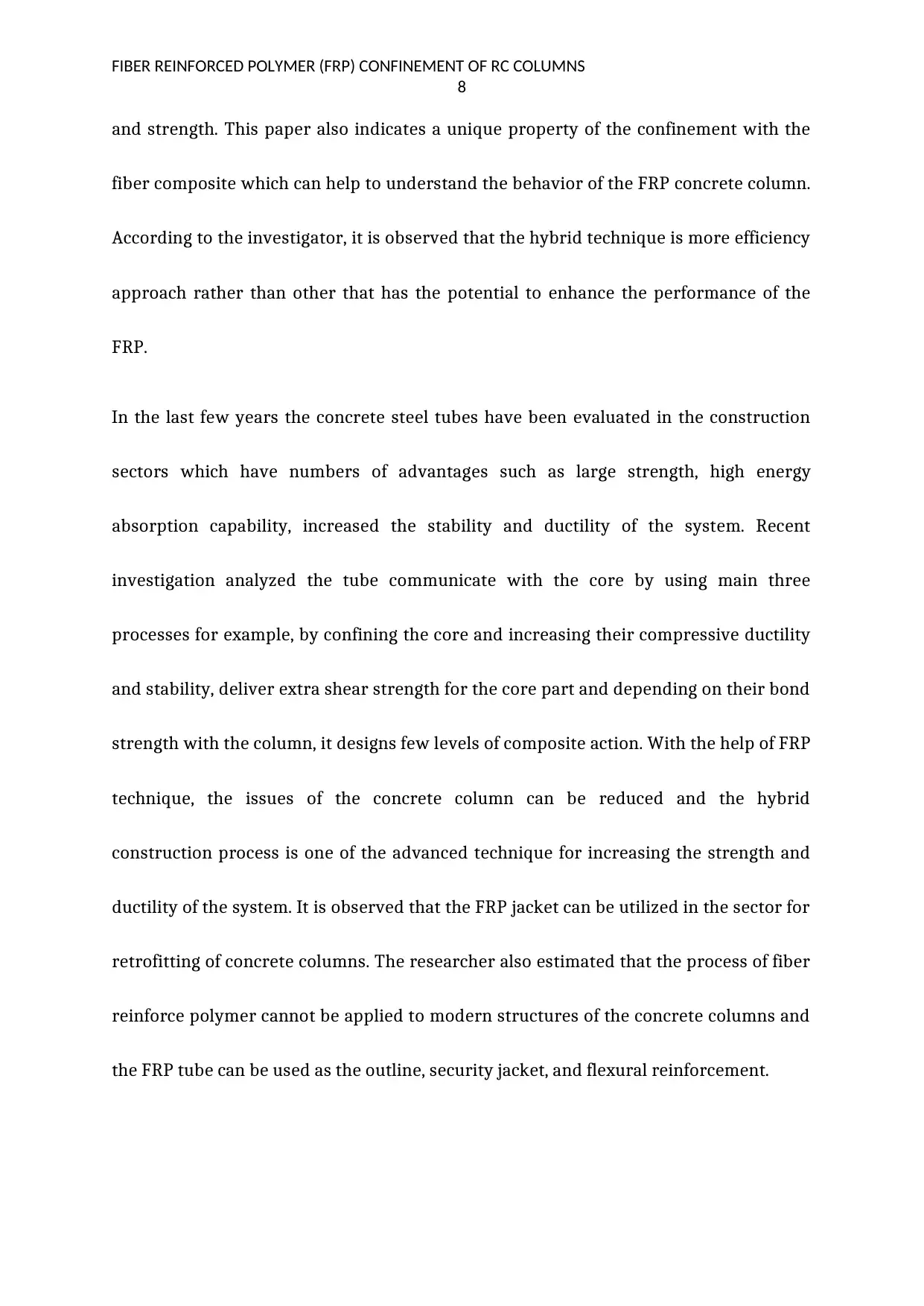
FIBER REINFORCED POLYMER (FRP) CONFINEMENT OF RC COLUMNS
8
and strength. This paper also indicates a unique property of the confinement with the
fiber composite which can help to understand the behavior of the FRP concrete column.
According to the investigator, it is observed that the hybrid technique is more efficiency
approach rather than other that has the potential to enhance the performance of the
FRP.
In the last few years the concrete steel tubes have been evaluated in the construction
sectors which have numbers of advantages such as large strength, high energy
absorption capability, increased the stability and ductility of the system. Recent
investigation analyzed the tube communicate with the core by using main three
processes for example, by confining the core and increasing their compressive ductility
and stability, deliver extra shear strength for the core part and depending on their bond
strength with the column, it designs few levels of composite action. With the help of FRP
technique, the issues of the concrete column can be reduced and the hybrid
construction process is one of the advanced technique for increasing the strength and
ductility of the system. It is observed that the FRP jacket can be utilized in the sector for
retrofitting of concrete columns. The researcher also estimated that the process of fiber
reinforce polymer cannot be applied to modern structures of the concrete columns and
the FRP tube can be used as the outline, security jacket, and flexural reinforcement.
8
and strength. This paper also indicates a unique property of the confinement with the
fiber composite which can help to understand the behavior of the FRP concrete column.
According to the investigator, it is observed that the hybrid technique is more efficiency
approach rather than other that has the potential to enhance the performance of the
FRP.
In the last few years the concrete steel tubes have been evaluated in the construction
sectors which have numbers of advantages such as large strength, high energy
absorption capability, increased the stability and ductility of the system. Recent
investigation analyzed the tube communicate with the core by using main three
processes for example, by confining the core and increasing their compressive ductility
and stability, deliver extra shear strength for the core part and depending on their bond
strength with the column, it designs few levels of composite action. With the help of FRP
technique, the issues of the concrete column can be reduced and the hybrid
construction process is one of the advanced technique for increasing the strength and
ductility of the system. It is observed that the FRP jacket can be utilized in the sector for
retrofitting of concrete columns. The researcher also estimated that the process of fiber
reinforce polymer cannot be applied to modern structures of the concrete columns and
the FRP tube can be used as the outline, security jacket, and flexural reinforcement.
⊘ This is a preview!⊘
Do you want full access?
Subscribe today to unlock all pages.

Trusted by 1+ million students worldwide
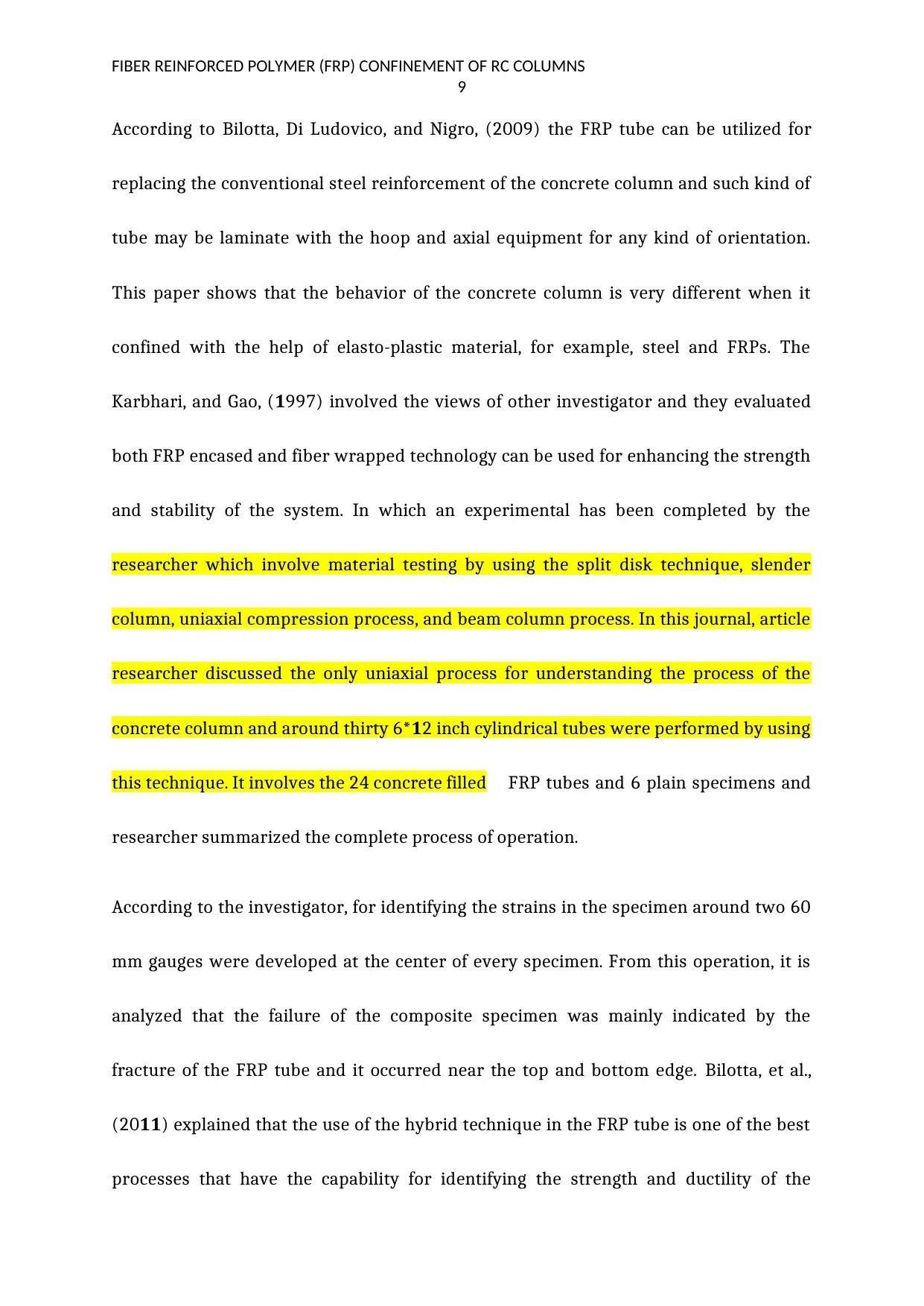
FIBER REINFORCED POLYMER (FRP) CONFINEMENT OF RC COLUMNS
9
According to Bilotta, Di Ludovico, and Nigro, (2009) the FRP tube can be utilized for
replacing the conventional steel reinforcement of the concrete column and such kind of
tube may be laminate with the hoop and axial equipment for any kind of orientation.
This paper shows that the behavior of the concrete column is very different when it
confined with the help of elasto-plastic material, for example, steel and FRPs. The
1Karbhari, and Gao, ( 997) involved the views of other investigator and they evaluated
both FRP encased and fiber wrapped technology can be used for enhancing the strength
and stability of the system. In which an experimental has been completed by the
researcher which involve material testing by using the split disk technique, slender
column, uniaxial compression process, and beam column process. In this journal, article
researcher discussed the only uniaxial process for understanding the process of the
1concrete column and around thirty 6* 2 inch cylindrical tubes were performed by using
this technique. It involves the 24 concrete filled FRP tubes and 6 plain specimens and
researcher summarized the complete process of operation.
According to the investigator, for identifying the strains in the specimen around two 60
mm gauges were developed at the center of every specimen. From this operation, it is
analyzed that the failure of the composite specimen was mainly indicated by the
fracture of the FRP tube and it occurred near the top and bottom edge. Bilotta, et al.,
11(20 ) explained that the use of the hybrid technique in the FRP tube is one of the best
processes that have the capability for identifying the strength and ductility of the
9
According to Bilotta, Di Ludovico, and Nigro, (2009) the FRP tube can be utilized for
replacing the conventional steel reinforcement of the concrete column and such kind of
tube may be laminate with the hoop and axial equipment for any kind of orientation.
This paper shows that the behavior of the concrete column is very different when it
confined with the help of elasto-plastic material, for example, steel and FRPs. The
1Karbhari, and Gao, ( 997) involved the views of other investigator and they evaluated
both FRP encased and fiber wrapped technology can be used for enhancing the strength
and stability of the system. In which an experimental has been completed by the
researcher which involve material testing by using the split disk technique, slender
column, uniaxial compression process, and beam column process. In this journal, article
researcher discussed the only uniaxial process for understanding the process of the
1concrete column and around thirty 6* 2 inch cylindrical tubes were performed by using
this technique. It involves the 24 concrete filled FRP tubes and 6 plain specimens and
researcher summarized the complete process of operation.
According to the investigator, for identifying the strains in the specimen around two 60
mm gauges were developed at the center of every specimen. From this operation, it is
analyzed that the failure of the composite specimen was mainly indicated by the
fracture of the FRP tube and it occurred near the top and bottom edge. Bilotta, et al.,
11(20 ) explained that the use of the hybrid technique in the FRP tube is one of the best
processes that have the capability for identifying the strength and ductility of the
Paraphrase This Document
Need a fresh take? Get an instant paraphrase of this document with our AI Paraphraser

FIBER REINFORCED POLYMER (FRP) CONFINEMENT OF RC COLUMNS
10
concrete column in very less time. The main drawback of this journal paper is that the
researcher did not provide any information about reinforcing polymer and compressive
strength and also does not reduce the research gaps of the previous investigation. In the
future, researcher will adopt the primary and secondary data analysis techniques to
gain an effective conclusion and avoid the cons of this investigation.
The primary data will be collected with the help of survey that obtained the views or
opinions of other individuals. According to 1Triantafillou, et al., (200 ) the state of the
art process is the utilization of the FRP techniques that are viewed by the engineers and
experts as a new and highly promising product in the construction sectors. The
researcher observed that there are few reasons for selecting the strengthening material
of FRP concrete such as immunity to corrosion, very low weight, easy to understand and
reduce the labor cost. The main objective of this paper is to highlight the key factors
which impact on the performance of the FRP material and evaluate the various
applications of the composite as EBR of the concrete column. The researcher also
provided the FRP strengthening materials and approaches and current development in
the field of FRP material.
The researcher observed that the selection of the FRP material is one of the biggest
problems and the resin system for the material of the fiber will not provide a good bond
with the concrete column. Researcher provided their views on this topic and estimated
10
concrete column in very less time. The main drawback of this journal paper is that the
researcher did not provide any information about reinforcing polymer and compressive
strength and also does not reduce the research gaps of the previous investigation. In the
future, researcher will adopt the primary and secondary data analysis techniques to
gain an effective conclusion and avoid the cons of this investigation.
The primary data will be collected with the help of survey that obtained the views or
opinions of other individuals. According to 1Triantafillou, et al., (200 ) the state of the
art process is the utilization of the FRP techniques that are viewed by the engineers and
experts as a new and highly promising product in the construction sectors. The
researcher observed that there are few reasons for selecting the strengthening material
of FRP concrete such as immunity to corrosion, very low weight, easy to understand and
reduce the labor cost. The main objective of this paper is to highlight the key factors
which impact on the performance of the FRP material and evaluate the various
applications of the composite as EBR of the concrete column. The researcher also
provided the FRP strengthening materials and approaches and current development in
the field of FRP material.
The researcher observed that the selection of the FRP material is one of the biggest
problems and the resin system for the material of the fiber will not provide a good bond
with the concrete column. Researcher provided their views on this topic and estimated
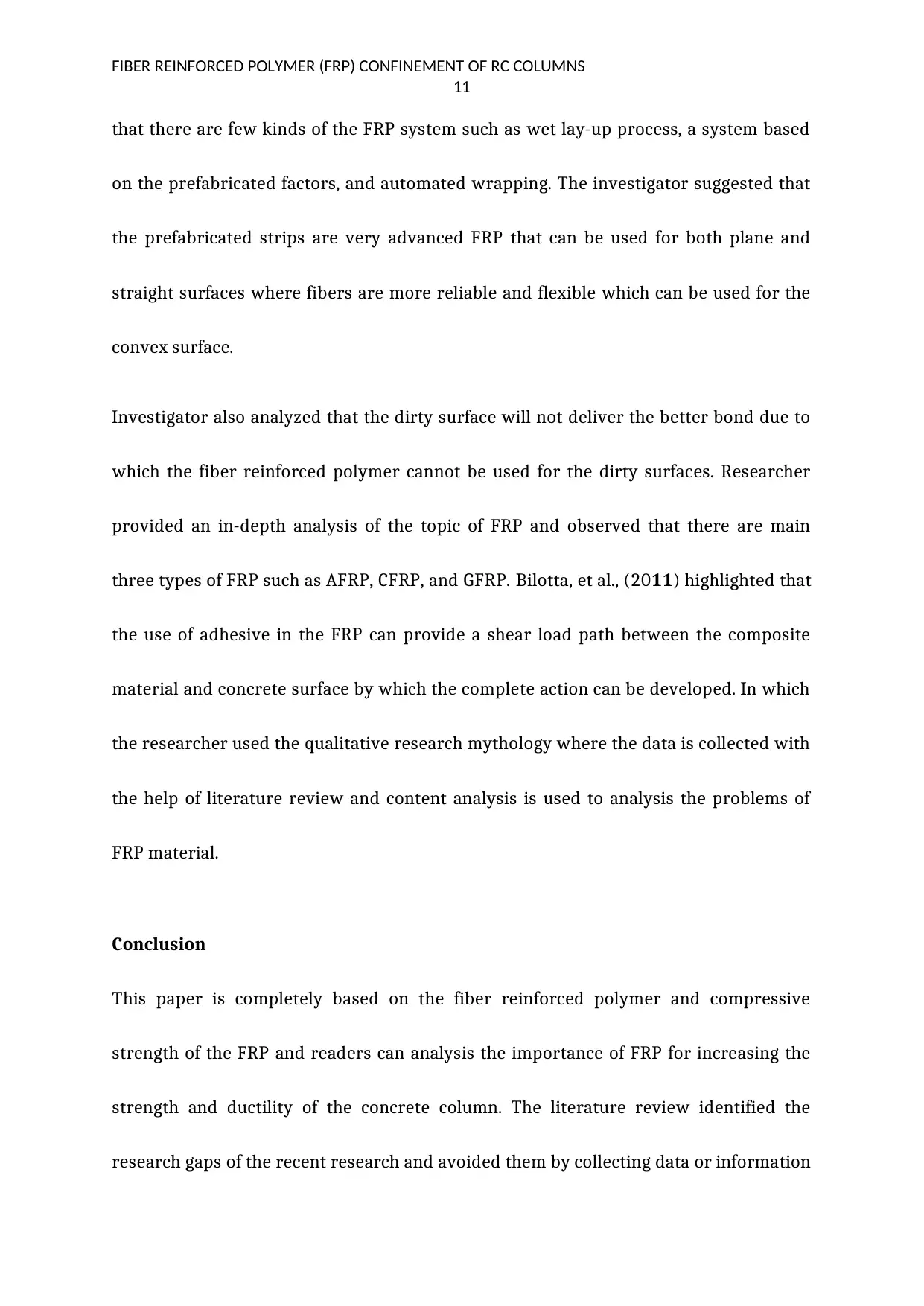
FIBER REINFORCED POLYMER (FRP) CONFINEMENT OF RC COLUMNS
11
that there are few kinds of the FRP system such as wet lay-up process, a system based
on the prefabricated factors, and automated wrapping. The investigator suggested that
the prefabricated strips are very advanced FRP that can be used for both plane and
straight surfaces where fibers are more reliable and flexible which can be used for the
convex surface.
Investigator also analyzed that the dirty surface will not deliver the better bond due to
which the fiber reinforced polymer cannot be used for the dirty surfaces. Researcher
provided an in-depth analysis of the topic of FRP and observed that there are main
three types of FRP such as AFRP, CFRP, and GFRP. Bilotta 11, et al., (20 ) highlighted that
the use of adhesive in the FRP can provide a shear load path between the composite
material and concrete surface by which the complete action can be developed. In which
the researcher used the qualitative research mythology where the data is collected with
the help of literature review and content analysis is used to analysis the problems of
FRP material.
Conclusion
This paper is completely based on the fiber reinforced polymer and compressive
strength of the FRP and readers can analysis the importance of FRP for increasing the
strength and ductility of the concrete column. The literature review identified the
research gaps of the recent research and avoided them by collecting data or information
11
that there are few kinds of the FRP system such as wet lay-up process, a system based
on the prefabricated factors, and automated wrapping. The investigator suggested that
the prefabricated strips are very advanced FRP that can be used for both plane and
straight surfaces where fibers are more reliable and flexible which can be used for the
convex surface.
Investigator also analyzed that the dirty surface will not deliver the better bond due to
which the fiber reinforced polymer cannot be used for the dirty surfaces. Researcher
provided an in-depth analysis of the topic of FRP and observed that there are main
three types of FRP such as AFRP, CFRP, and GFRP. Bilotta 11, et al., (20 ) highlighted that
the use of adhesive in the FRP can provide a shear load path between the composite
material and concrete surface by which the complete action can be developed. In which
the researcher used the qualitative research mythology where the data is collected with
the help of literature review and content analysis is used to analysis the problems of
FRP material.
Conclusion
This paper is completely based on the fiber reinforced polymer and compressive
strength of the FRP and readers can analysis the importance of FRP for increasing the
strength and ductility of the concrete column. The literature review identified the
research gaps of the recent research and avoided them by collecting data or information
⊘ This is a preview!⊘
Do you want full access?
Subscribe today to unlock all pages.

Trusted by 1+ million students worldwide
1 out of 15
Related Documents
Your All-in-One AI-Powered Toolkit for Academic Success.
+13062052269
info@desklib.com
Available 24*7 on WhatsApp / Email
![[object Object]](/_next/static/media/star-bottom.7253800d.svg)
Unlock your academic potential
Copyright © 2020–2025 A2Z Services. All Rights Reserved. Developed and managed by ZUCOL.





